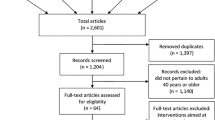Abstract
This study seeks to ascertain whether a culturally tailored art calendar could improve participation in cancer screening activities. We conducted a randomized, controlled calendar mail-out in which a Native art calendar was sent by first class mail to 5,633 patients seen at an urban American Indian clinic during the prior 2 years. Using random assignment, half of the patients were mailed a “message” calendar with screening information and reminders on breast, colorectal, lung, and prostate cancer; the other half received a calendar without messages. The receipt of cancer screening services was ascertained through chart abstraction in the following 15 months. In total, 5,363 observations (health messages n = 2,695; no messages n = 2,668) were analyzed. The calendar with health messages did not result in increased receipt of any cancer-related prevention outcome compared to the calendar without health messages. We solicited clinic input to create a culturally appropriate visual intervention to increase cancer screening in a vulnerable, underserved urban population. Our results suggest that printed materials with health messages are likely too weak an intervention to produce the desired behavioral outcomes in cancer screening.

Similar content being viewed by others
References
Aspy CB, Mold JW, Thompson DM, Blondell RD, Landers PS, Reilly KE, Wright-Eakers L (2008) Integrating screening and interventions for unhealthy behaviors into primary care practices. Am J Prev Med 35(5):S373
Steele CB, Cardinez CJ, Richardson LC, Tom-Orme L, Shaw KM (2008) Surveillance for health behaviors of American Indians and Alaska Natives—findings from the behavioral risk factor surveillance system, 2000–2006. Cancer 113(5):1131–1141
U.S. Census Bureau. 2002. The American Indian and Alaska Native population 2000: Census 2000 Brief. Washington D.C.: U.S. Bureau of the Census
Kolb B, Wallace AM, Hill D, Royce M (2006) Disparities in cancer care among racial and ethnic minorities. Oncology 20(10):1256–1270
Indian Health Service (2001) Trends in Indian health. Rockville: U.S. Department of Health and Human Services
Portland Area Indian Health Board (2010) American Indian and Alaska Native cancer incidence and screening: Washington, 2001–2005. http://www.npaihb.org/images/projects_docs/NWTCCP/WashingtonAI-ANfactsheet2009.pdf Accessed 26 November 2010
Schumacher M, Slattery M, Lanier A, Ma Khe-Ni, Edwards S, Ferucci E, Tom-Orme L (2008) Prevalence and predictors of cancer screening among American Indian and Alaska native people: the EARTH study. Cancer Causes Control 19(7):725–737
Katz M, Kauffman R, Tatum C, Paskett E (2008) Influence of church attendance and spirituality in a randomized controlled trial to increase mammography use among a low-income, tri-racial, rural community. J Relig Health 47(2):227–236
Dignan MB, Robert Michielutte H, Wells B, Sharp P, Karen Blinson L, Case D, Bell R, Konen J, Davis S, McQuellon RP (1998) Health education to increase screening for cervical cancer among Lumbee Indian Women in North Carolina. Health Educ Res 13(4):545–556
Forquera, Ralph (2010) The Seattle Indian Health Board. Urban Indian Health. http://www.kff.org/minorityhealth/6006-index.cfm. Accessed 8 September 2010
Seattle Indian Health Board (2010) Mission statement. http://www.sihb.org/. Accessed 8 September 2010
Roppolo K (2007) Vision, voice, and intertribal metanarrative: the American Indian visual-rhetorical tradition and Leslie Marmon Silko’s Almanac of the Dead. Am Indian Q 31(4):534–558
U.S. Preventative Task Force (2010) Recommendations. http://www.ahrq.gov/CLINIC/uspstfix.htm#Recommendations. Accessed 30 September 2010
Maglione MA, Stone EG, Shekelle PG (2002) Mass mailings have little effect on utilization of influenza vaccine among Medicare beneficiaries. Am J Prev Med 23(1):43–46
McCaul KD, Wold KS (2002) The effects of mailed reminders and tailored messages on mammography screening. J Community Health 27(3):181–190
Hodge FS, Fredericks L, Rodriguez B (1996) American Indian women’s talking circle: a cervical cancer screening and prevention project. Cancer 78(7):1592–1597
Dillman DA, Smyth JD, Christian LM (2009) Internet, mail and mixed-mode surveys: the tailored design method. Wiley, New York
Garrett SK, Thomas AP, Cicuttini F, Silagy C, Taylor HR, McNeil JJ (2000) Community-based recruitment strategies for a longitudinal interventional study. J Clin Epidemiol 53(5):541–548
Duffy D, Goldberg J, Buchwald D (2006) Using mail to reach patients seen at an urban health care facility. J Health Care Poor Underserved 17(3):522–531
Moher D, Schulz KF, Altman DG (2001) The CONSORT statement: revised recommendations for improving the quality of reports of parallel-group randomized trials. Ann Intern Med 134(8):657–662
Acknowledgments
This effort was supported by the National Institute of Aging (P30 AG15297, S. Manson), Agency for Healthcare Research and Quality (P01 HS10854, S. Manson), National Center for Minority Health and Health Disparities (P60 MD000507, S. Manson), and by Native People for Cancer Control, a Community Networks Program of the National Cancer Institute (U01 CA114642, D. Buchwald). The content is solely the responsibility of the authors and does not necessarily reflect the official views of the National Institutes of Health or the Agency for Healthcare Research and Quality.
Conflict of Interest
The authors declare that they have no conflicts of interest of any kind.
Author information
Authors and Affiliations
Corresponding author
Rights and permissions
About this article
Cite this article
Doorenbos, A.Z., Jacobsen, C., Corpuz, R. et al. A Randomized Controlled Calendar Mail-Out to Increase Cancer Screening Among Urban American Indian and Alaska Native Patients. J Canc Educ 26, 549–554 (2011). https://doi.org/10.1007/s13187-011-0217-z
Published:
Issue Date:
DOI: https://doi.org/10.1007/s13187-011-0217-z



